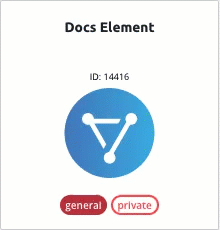QuickBooks Enterprise
Authenticate with QuickBooks Enterprise
You can authenticate with QuickBooks Enterprise to create your own instance of the QuickBooks Enterprise element through the UI or through APIs. Once authenticated, you can use the element instance to access the different functionality offered by the QuickBooks Enterprise platform.
Authenticate Through the UI
Use the UI to authenticate with QuickBooks Enterprise and create an element instance. QuickBooks Enterprise uses a simple authentication method for its connections. All we need is the exact app name that is setup in QuickBooks, and the endpoint IP or URL (most likely a Ground2Cloud URL).
If you are configuring events, see the Events section.
To authenticate an element instance:
- Sign in to Cloud Elements, and then search for QuickBooks Enterprise in our Elements Catalog.

- Hover over the element card, and then click Authenticate.

- Enter a name for the element instance.
- In Configured Application Name, enter the application name that is configured in the QuickBooks application.
- In Host Name/IP, enter the address of the application endpoint. In most cases, this will be a Ground2Cloud address. The Ground2Cloud endpoint will look something like:
https://1234.g2c.cloud-elements.com. Where1234is the number specific to your application. The reason for using Ground2Cloud is so that the Cloud Elements servers can communicate with an on-premise installation of QuickBooks Enterprise, without the need to open up firewalls to your site. - Click Create Instance.
After successfully authenticating, we give you several options for next steps. Make requests using the API docs associated with the instance, map the instance to a virtual data resource, or use it in a formula template.
Authenticate Through API
Authenticating through API is as simple as providing the necessary authentication parameters in the request body in order to Authenticate the element instance.
Authenticating the Element Instance
Use the /instances endpoint to authenticate with QuickBooks Enterprise and create an element instance. If you are configuring events, see the Events section.
To create an element instance:
Construct a JSON body as shown below (see Parameters):
{ "element": { "key": "quickbooksonprem" }, "configuration": { "filter.response.nulls": "true", "app.name": "<APP_NAME>", "host.ip": "<HOST_IP>" }, "tags": [ "<Add_Your_Tag>" ], "name": "<INSTANCE_NAME>" }Call the following, including the JSON body you constructed in the previous step:
POST /instancesNote: Make sure that you include the User and Organization keys in the header. See the Overview for details.Locate the
tokenandidin the response and save them for all future requests using the element instance.
Example cURL
curl -X POST \
https://api.cloud-elements.com/elements/api-v2/instances \
-H 'authorization: User <USER_SECRET>, Organization <ORGANIZATION_SECRET>' \
-H 'content-type: application/json' \
-d '{
"element": {
"key": "quickbooksonprem"
},
"configuration": {
"filter.response.nulls": "true",
"app.name": "<APP_NAME>",
"host.ip": "<HOST_IP>"
},
"tags": [
"QuickBooks"
],
"name": "QuickBooks Enterprise"
}'
Parameters
API parameters not shown in Cloud Elements are in code formatting.
| Parameter | Description | Data Type |
|---|---|---|
Keykey |
The element key. quickbooksonprem |
string |
Namename |
The name for the element instance created during authentication. | Body |
Configured Application Nameapp.name |
The Configured Application Name that you noted in API Provider Setup. | string |
Host Name/IPhost.ip |
The Host Name/IP that you noted in API Provider Setup. | string |
Filter null values from the response filter.response.nulls |
Optional. Determines if null values in the response JSON should be filtered from the response. Yes or true indicates that Cloud Elements will filter null values. Default: true. |
boolean |
| tags | Optional. User-defined tags to further identify the instance. | string |
Example Response
{
"id": 1,
"name": "QuickBooks Enterprise",
"createdDate": "2017-06-06T19:08:52Z",
"token": "pIHuafNc/17ADfEjcqIsFZ9eNNk58dXSEdqhC5QnQBk=",
"element": {
"id": 195,
"name": "QuickBooks Enterprise",
"hookName": "QuickBooksEnterprise",
"key": "quickbooksonprem",
"description": "Add a QuickBooks Enterprise Instance to connect your existing QuickBooks Enterprise account to the Finance Hub, allowing you to manage your customers, employees, invoices, purchase orders etc. across multiple Finance Elements. You will need your QuickBooks Enterprise account information to add an instance.",
"image": "elements/provider_quickbooks.png",
"active": true,
"deleted": false,
"typeOauth": true,
"trialAccount": false,
"configDescription": "QuickBooks Desktop Element",
"defaultTransformations": [{"...": "..."}]
},
"elementId": 195,
"provisionInteractions": [],
"valid": true,
"disabled": false,
"maxCacheSize": 0,
"cacheTimeToLive": 0,
"configuration": {
"bulk.add_metadata": "false",
"event.notification.subscription.id": null,
"bulk.query.field_name": "TimeModified",
"event.vendor.type": "polling",
"bulk.query.operator": ">=",
"filter.response.nulls": "true",
"bulk.query.date_mask": "yyyy-MM-dd'T'HH:mm:ssXXX",
"host.ip": "<HOST_IP>",
"bulk.query.download_format": "json",
"bulk.attribute.created_time": "TimeCreated",
"bulk.relations": "{}",
"event.poller.refresh_interval": "15",
"event.notification.callback.url": null,
"event.notification.signature.key": null,
"bulk.attribute.modified_time": "TimeModified",
"event.poller.urls": null,
"event.poller.configuration": "...",
"app.name": "<APP_NAME>",
"event.notification.enabled": "false"
},
"eventsEnabled": false,
"traceLoggingEnabled": false,
"cachingEnabled": false,
"externalAuthentication": "none",
"user": {
"id": "..."
}